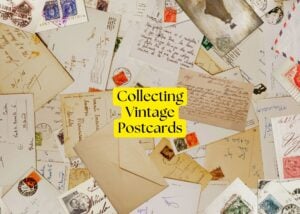Postcard collecting, formally called deltiology, is one of America’s most popular hobbies. People love collecting different types of postcards from different eras. But what many don’t know is that these cards are more than just collectible items; they’re a fortune in disguise.
That’s right, old postcards have been selling for a few dollars to tens of thousands. The huge value range means that knowing what makes a postcard valuable is crucial. And that’s what this guide will help you with.
How to Spot Authentic Vintage Postcards?
Old antique postcards looked very different from what you’ll imagine. Why? Because the printing was different, the U.S. Post Office regulations were different, and even the subject matter of the cards was different.
So you need to carefully assess these features to identify a vintage postcard. Below is an easy walk-through of these definitive clues you need to look for.
Types of Postcards
The design, especially on the back of the postcard, is probably the most reliable dating clue. These different designs, popular in various eras, also categorize vintage postcards as notable types.
The following table will help you identify the various types of postcards and date them:
| Postcard Type/Era | Approximate Dates | Key Features | Notes |
| Pioneer Era | 1870–1898 | No divided back. | Early government-issued postal cards and World’s Fair exclusives, rare |
| Private Mailing Cards | 1898–1901 | Undivided back. Required 1-cent adhesive stamp. | Marked “Private Mailing Card, Authorized by Act of Congress in 1898 |
| Undivided Back Cards | 1901–1907 | No dividing line on back, back reserved for address only | Messages written on the front beside the image. |
| Divided Back Cards | 1907–1915 | Back divided into address and message sections | Superior German printing quality, most collectible. |
| White Border Photochrome/Chrome Cards | 1915–1930 | Divided back retained with white borders around images | German imports, with lower-quality American printing |
| Linen Cards | 1930–1945 | Textured linen-like finish on high rag content card stock | Popularized by Curt Teich & Co., shows vibrant colors |
| Photochrome/Chrome | 1939–Present | Glossy finish with color photographic images | Standard size 3½” × 5½”, later raised to 4″ × 6″) |
Type of Art/Design Printing
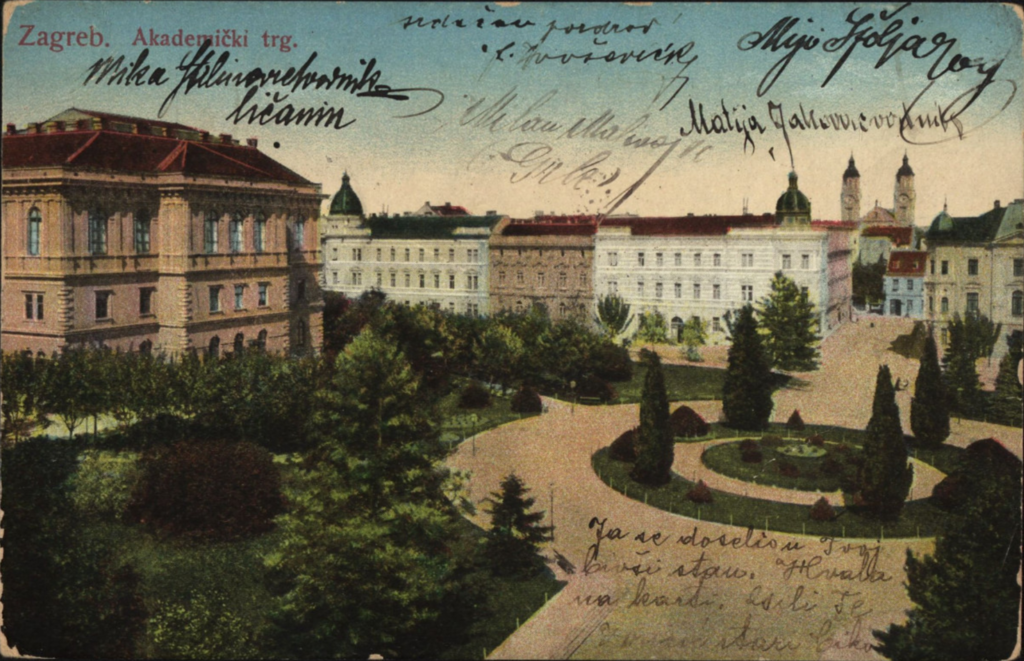
Vintage postcards show a wide range of designs, from real photos to animated drawings and cartoons. Here’s how you can identify these different styles:
- Real Photo Postcards (RPPCs): Real photo postcards are actual photographs developed onto postcard paper. These are NOT printed images. To identify them, use a magnifying glass. If you see dot patterns like newspaper photos, it’s printed. If it’s a solid, continuous image, it’s RPPC.
- Lithographic Cards: These use stone or plate lithography, giving rich color and detail on cards from the late 1800s and early 1900s. It’s common for divided back, white border, and early holiday cards. Lithographs show solid color areas with fewer dots.
- Printed (Halftone or Offset) Cards: A common type from the 1910s onward, these use a grid of tiny dots to render images. You can identify them with a magnifier; images break down into a dot pattern. Common for many ”linen” postcards and chrome cards.
- Hand-tinted/Hand-colored Cards: These are black & white photographic or lithographed images colored by hand. So, you’ll see uneven coloring and brush marks. Many RPPCs were hand-tinted, adding extra character and value.
Artist & Publisher Marks
A reputable publisher mark or a known artist’s signature instantly adds provenance and quality assurance. You will usually find these signs/stamps/logos at the bottom edge, corner, or back.
German publisher Raphael Tuck & Sons, along with American publishers John Winsch, Curt Teich & Co., The Albertype Company, and Detroit Publishing Company, are renowned for creating some of the most iconic and popular postcards.
Similarly, Ellen H. Clapsaddle’s sentimental and prolific holiday and children’s theme postcards and Louis Wain’s signed, bizarre anthropomorphic cat-themed cards are highly desirable.
Frances Brundage, Grace Gebbie Drayton, Raphael Kirchner, Alphonse Mucha, and Rose O’Neill are some other names whose signed postcards are sought-after.
Signs of Authenticity
Checking a postcard’s authenticity involves looking for specific physical and printed details, as well as the natural aging and wear signs of materials over time.
Postmarks and Usage
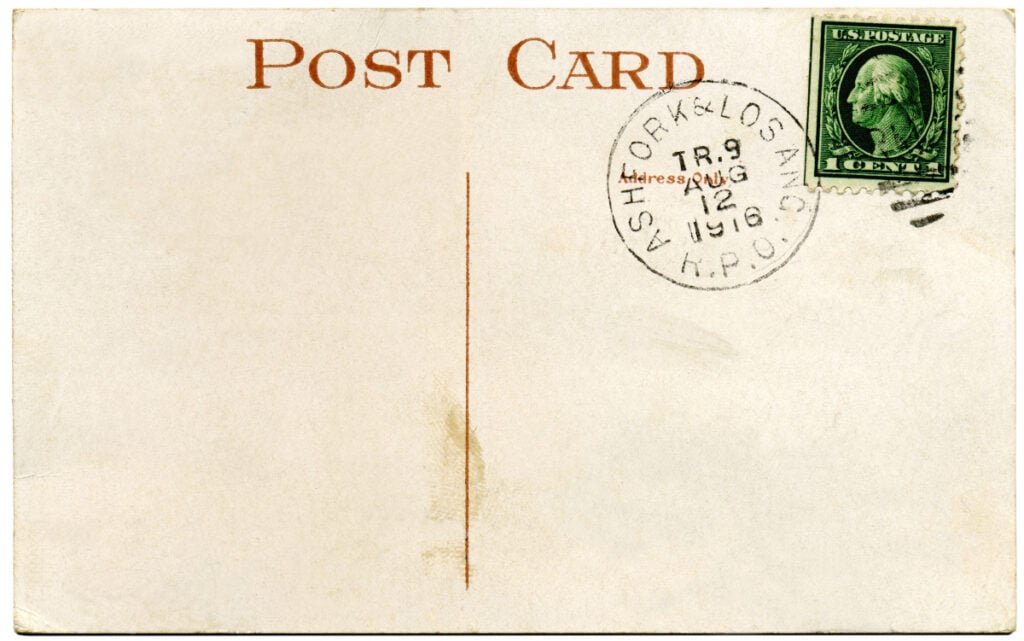
For old postcards, postmarks can make or break value. If a card is postally used, the value of postal markings can sometimes exceed the image value itself. Besides, better-quality postcards always show clearer postmarks.
Also, postmarks are crucial, especially for cards from areas where native usage was small, like Pacific Ocean islands.
Rare postmarks, like those mailed in advance for Christmas day delivery or featuring hand-drawn cancellations, can also prove authenticity and add value. Just make sure those are genuine.
Postal Rates
Postage can also help verify and date a vintage postcard. The U.S. domestic postcard rate was 1 cent for an extremely long period, from 1898 until 1951. If the card has a 1-cent printed stamp or an unused box marked for 1-cent postage, it’s from the pre-1951 era.
Genuine Aging Signs
Truly vintage postcards usually show a subtle, overall patina and yellowing, due to acid content and exposure to air and light over many decades. You may also sometimes see small, dark brown or reddish-brown age spots (foxing).
Another common thing is “album marks.” Many antique postcards were stored in albums, which leave their impressions. Look for faint indentations, crescent-shaped marks, or minor thinning where a card was repeatedly placed and removed. Also, corner wear is common.
What Makes Antique/Vintage Postcards Valuable?
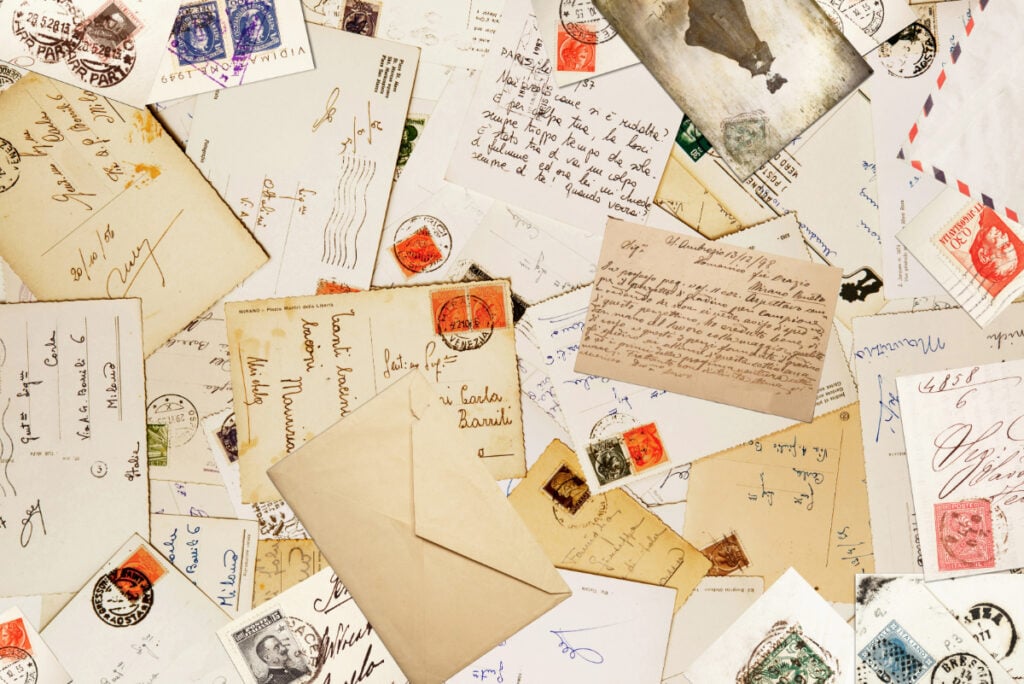
Vintage postcards are a big attraction, but that doesn’t mean that every old card will be worth hundreds. That’s because the overall worth of a card depends on several factors. I’ve explained them below:
Condition
Needless to say, nobody would want to pay hundreds for a postcard that’s torn and has too many creases or a faded photo or art. That’s why condition matters the most for valuing old postcards.
The most valuable are the pristine postcards, professionally graded as “Mint,” that look like they’re just issued. They’re unposted, without bends, creases, writing, or postmarks, with a clean appearance, fresh colors, and sharp corners. But you’ll rarely see Mint vintage cards.
“Like Mint” postcards show very slight aging or discoloration, probably from album storage. Otherwise, they’re clean and perfect and valuable.
The value reduces from Mint down to examples with more damage, with Fair and Poor examples being worth the least. These cards show the highest wear and tear, like massive tears, discoloration, and folds.
Subject Matter
The subject of a vintage postcard is its greatest value driver. From popular landmarks to popular celebrities, here are some of the collectible subject matters:
- Scarce Town Views: Early, animated street scenes of small, less-photographed American towns, especially before 1910, are highly collectible. You’ll see early cars, trolleys, specific local business signs, or structures that no longer exist.
- The Big Four Holidays: Halloween cards are consistently the most valuable holiday category. Also sought are early, elaborate Christmas, Thanksgiving, and New Year’s designs, especially those with embossing or unique themes like anthropomorphic cats or rare Santa suit colors.
- Aviation & Transportation: Early pre-1920 images of airships, biplanes, specific train wrecks, or iconic Route 66 motels are considered rare and valuable.
- Mechanical & Novelty Cards: Cards with moving parts (Mechanical), those revealing a second image when held up to the light (Hold-to-Light), or those with elaborate die-cut shapes always fetch high amounts.
Rarity
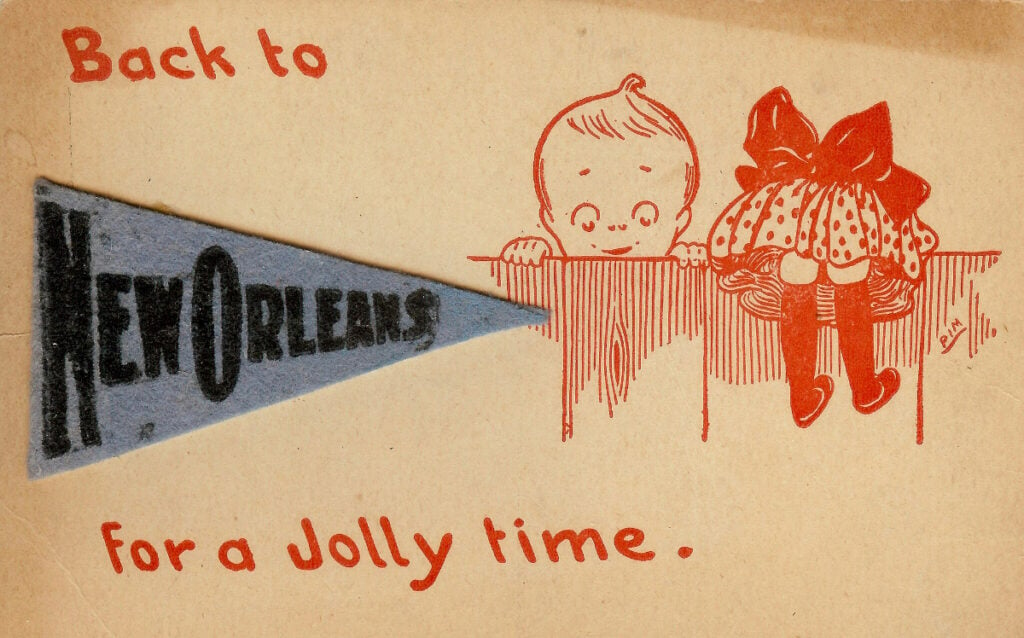
If a postcard is one of only a few cards ever printed or survived, it may be very valuable. For example, real photographic postcards printed directly from negatives were often made in very limited numbers by local photographers during 1902-1918. Hence, they’re rare.
Likewise, cards with unique messages, content signed by a celebrity, a notable historical figure, or the actual photographer are instantly rarer and worth more.
Error cards with identifiable printing anomalies, such as misspelled text or specific color errors, are collectors’ favorites. Since created by mistakes, its production is always very low.
But note that rarity must work with other characteristics, because a single surviving card of an uninteresting or newer topic may be the only one in existence. If no one wants it, rarity doesn’t matter.
Unique Features
A postcard with special features can be double the worth of a regular card.
For example, mechanical postcards with moving parts, especially Ellen Clapsaddle’s Halloween designs, can reach into the hundreds of dollars. Similarly, Hold-to-light postcards are super valuable.
Other unique features that can bring value are gelatin coatings (causing a glossy, crackled surface over time), unique die-cut shapes, and add-on elements, like the felt cat designs on Alfred Stiebel’s cards.
10 Examples of Valuable Vintage Postcards Worth Money!
1. Halloween Witch’s Want Embossed Postcard
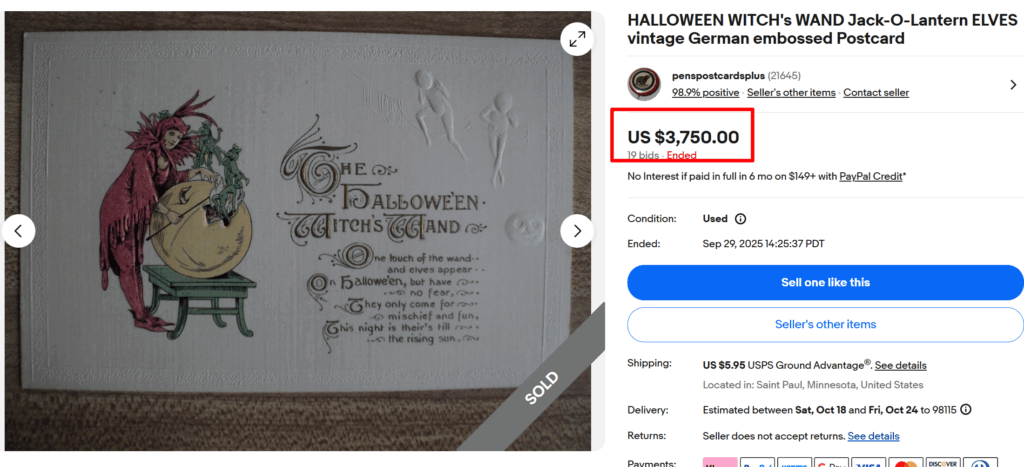
Halloween postcards from 1900 to 1920 are one of the most popular and valuable examples, especially from German publishers. This card here shows a witch with her wand next to a jack-o-lantern and playful elves.
Other key features are those white embossed figures and details. Witches, JOLs, and fantasy elements like these can boost old postcards’ value a lot. You can easily expect them to sell for hundreds and thousands if the embossing isn’t flattened, the colors remain bright, and there’s no major creasing or corner damage.
2. Nathan Road, Kowloon, China RPPC Postcard (1940s)
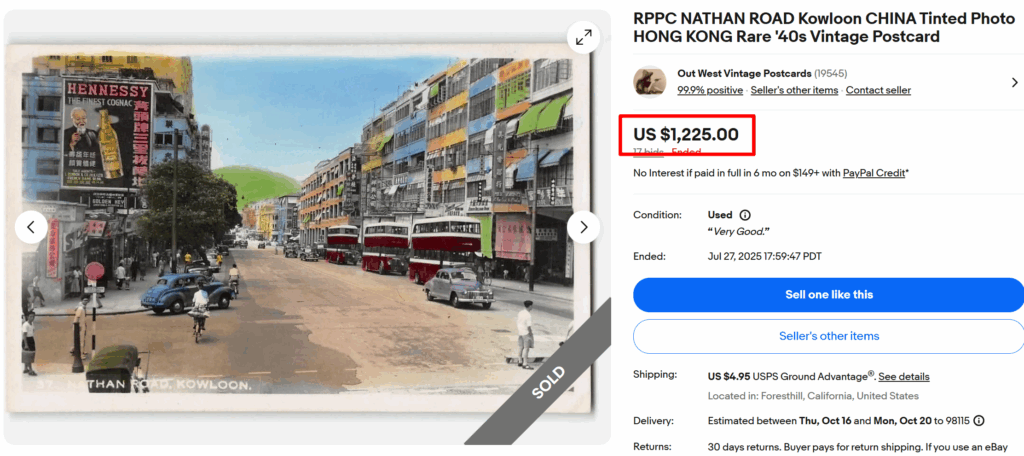
RPPCs are like treasures for postcard collectors. These cards show actual photographs printed on postcard stock, making each one unique. This example shows Nathan Road in Kowloon during the 1940s, with its bustling street scene hand-tinted in soft colors.
You can see the iconic double-decker buses, vintage cars, and the Hennessy sign from that famous shopping district. Hong Kong postcards from before the 1950s are especially rare and valuable because so few survived.
3. Jimmie Foxx Signed RPPC Post Card
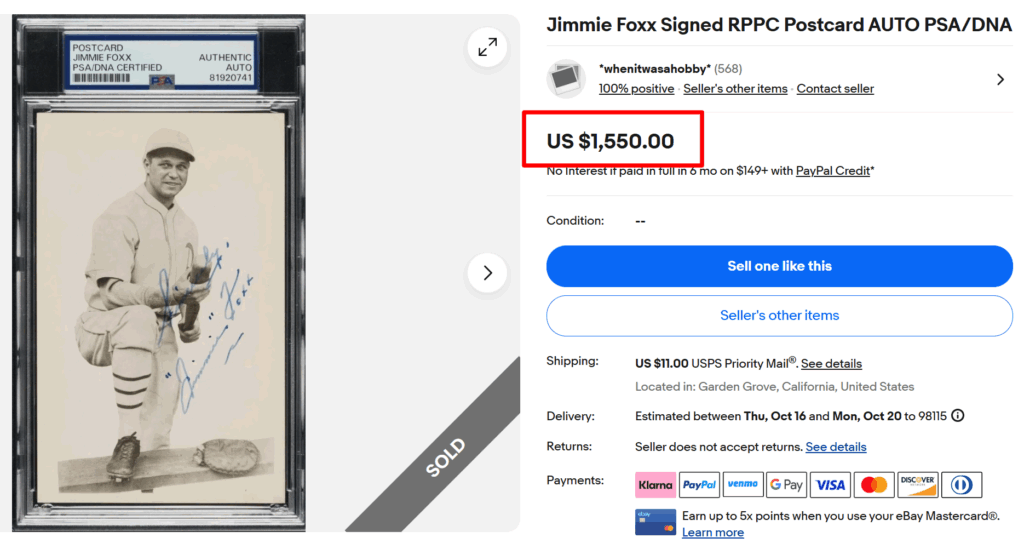
Vintage baseball postcards consistently sell well. Many examples have sold for over $1,000, just like this RPPC card. It features baseball legend Jimmie Foxx in his uniform and also includes his authentic autograph, which makes it even more historically significant!
Since he died young in 1967, finding Foxx’s signed items, especially postcards, is super tough today. Also, remember that his signature changed over his lifetime, so authentication is crucial. This example was verified by PSA/DNA, which proves it’s genuine.
4. Coca-Cola Advertising Postcard
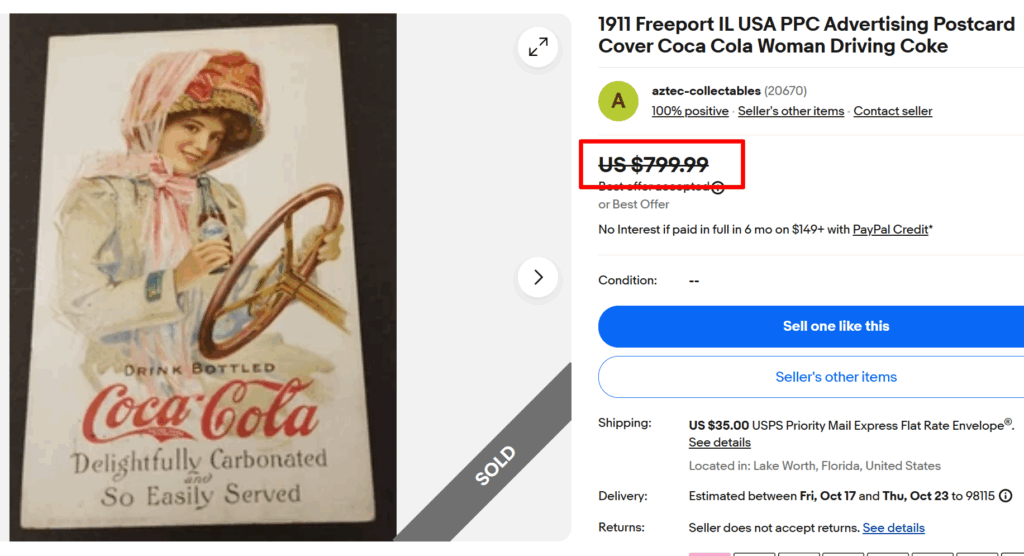
This super-rare advertising postcard from 1911 shows a well-dressed woman behind the wheel, promoting “Drink Bottled Coca-Cola.” The card was mailed from Freeport, Illinois, and features the iconic script “Coca-Cola” logo along with “Delightfully Carbonated and So Easily Served.”
Early Coca-Cola postcards from this era are super collectible because they show the company’s marketing during its first 25 years. Examples with vibrant colors, minimal creasing, and clear printing of the text and logo can sell for $400 to $1,000.
5. Christmas Hold to Light Santa Postcard
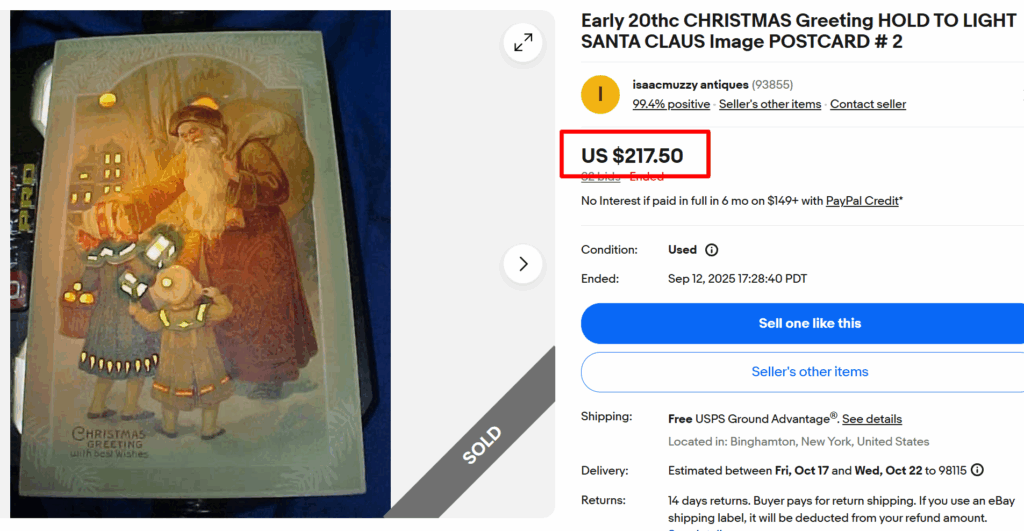
Vintage Hold-to-light postcards are most desirable. They used translucent paper layers and show hidden details like glowing windows or candles when you hold them up to a light source. This early 20th-century German-made card shows Santa delivering toys with children nearby, with lit-up details on the outfits and windows in the back.
You can spot authentic vintage cards by embossed details and extra texture. Today these unique cards are highly sought after by collectors, especially holiday-themed ones, fetching $100 to $300+.
6. Alfred Stiebel Felt Cat Add-On Halloween Postcard
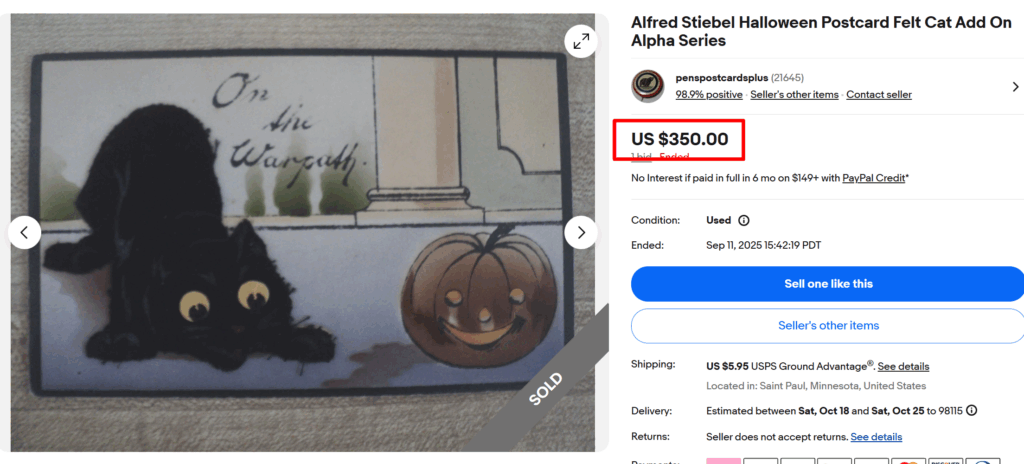
This is a cute postcard from publisher Alfred Stiebel, whose “Alpha Series” from the early 1900s is known for quality printing! It’s a Halloween-themed card featuring a three-dimensional black felt cat attached to the card!
The cat design is applied on the card, giving them the name “add-on” or “appliqué” postcards. Felt additions were popular novelty features that made postcards more special. Cards with intact felt can be worth a few hundred dollars.
7. Alphonse Mucha’s ‘The Months of the Year’ Postcards
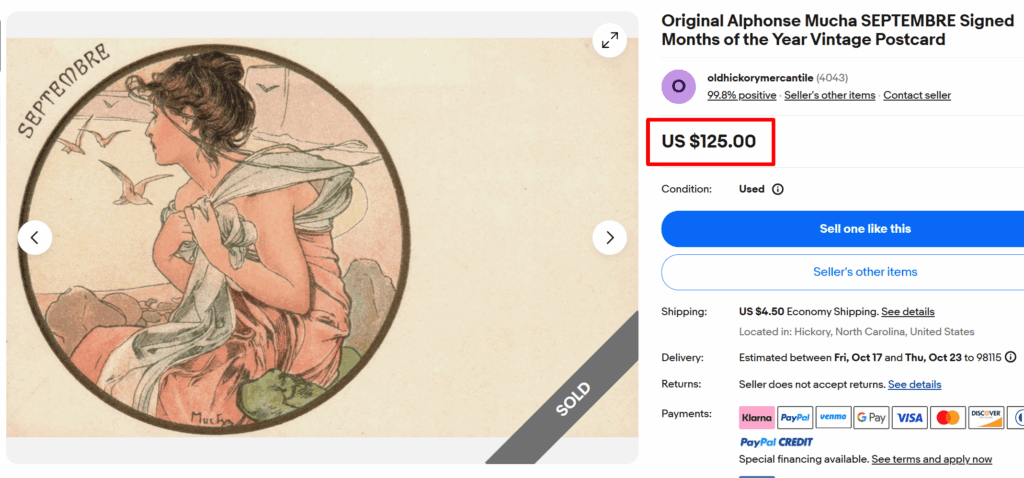
This is one of Alphonse Mucha’s “The Months of the Year” postcards set. This popular Art Nouveau set has 12 postcards, each denoting a month through Mucha’s unique, flowing female allegorical figures adorned with rich floral motifs in a circular frame.
The original designs appeared on the cover of the French magazine “Le Mois Littéraire” between 1899 and 1900. Then they were reproduced on postcards in the early 1900s.
Original, signed postcards from this set can fetch around $100 per card; the complete set can be worth up to $1,000 or more, because it’s difficult to find.
8. Betty Boop & Mickey Mouse Japanese Postcard (1935)
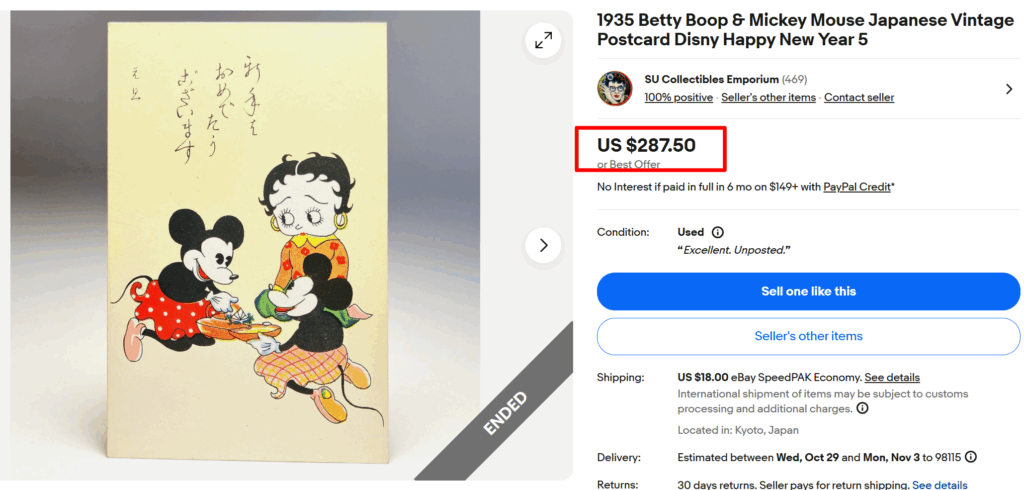
This adorable Japanese postcard from 1935 shows Betty Boop and Mickey Mouse together celebrating the New Year. This fascinating combination of two popular cartoon characters from completely different studios, Fleischer Studios and Disney, is what makes it special.
Also, pre-war Japanese Disney items like these are quite rare and valuable. To check if it’s authentic, check the Japanese text at the top and the “Seikyokudo/Tokyo/Japan” stamp at the back.
9. Mailick Santa Postcard
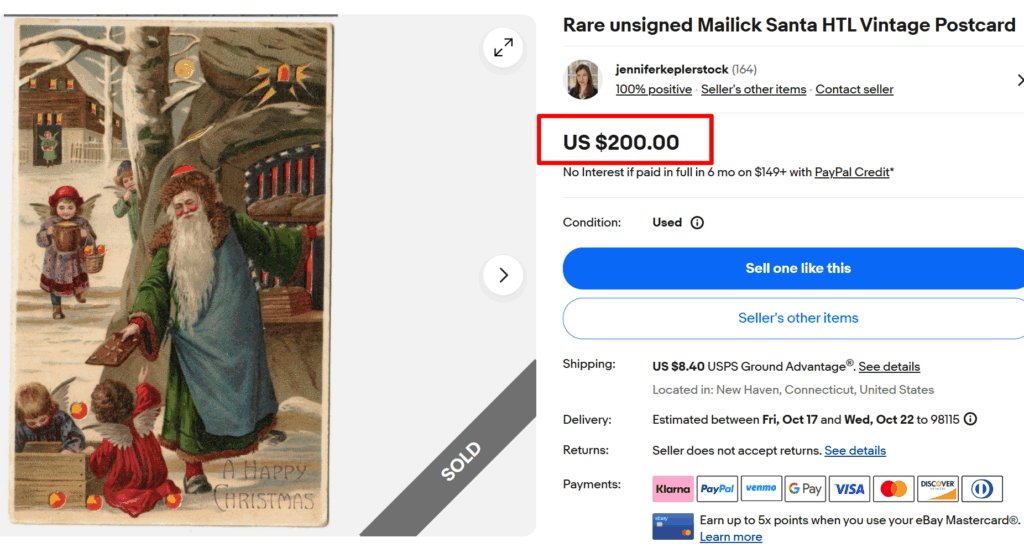
German publisher Mailick created some of the most beautiful embossed Christmas postcards in the early 1900s. This is another hold-to-light example featuring Santa with detailed embossing and windows that glow when backlit. The combination of embossing and HTL technology makes these especially valuable.
10. Louis Wain Cat Postcards
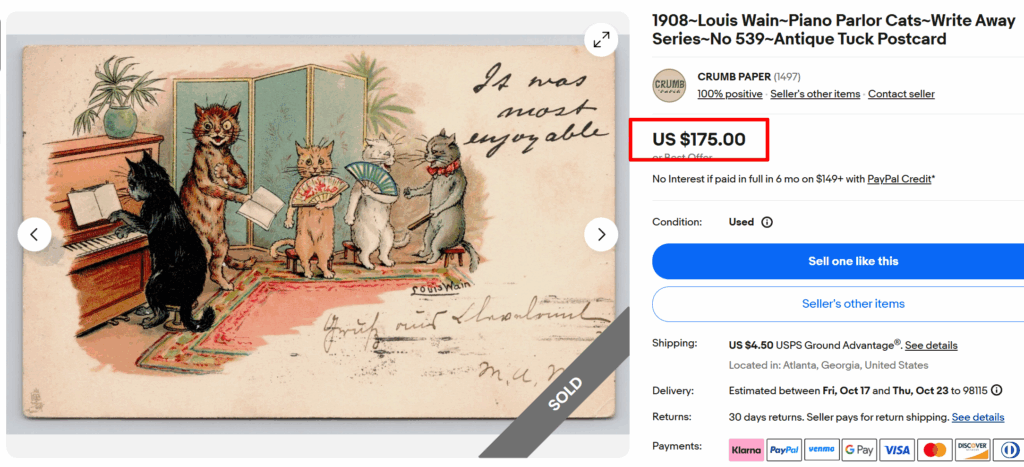
This Louis Wain postcard shows his signature anthropomorphic cats in a parlor setting, with felines playing piano and holding fans. It’s part of his “Write Away Series” (No. 539) published by Tuck.
What makes it valuable? Wain’s cute and life-like cat illustrations are highly collectible, especially the early 1900s pieces in good condition. If you can find his distinctive signature on the painting, that’s even better.
Note: This article is intended for informational, educational, and entertainment purposes only. Some images are illustrative and may not represent actual brands, products, or related entities. All trademarks, product names, brand logos, packaging, and other intellectual property referenced remain the exclusive property of their respective owners. Any brand mentions or references are provided solely for descriptive and educational context and do not imply any formal or commercial association.

